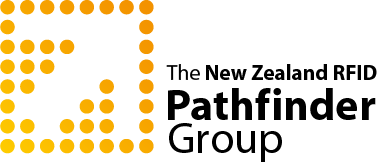Radio Frequency Identification (RFID)
Track and trace objects using radio waves.
Each RFID application consists of RFID tags, readers, and a computer system. Tags are made up of a microchip and an antenna and come in a variety of shapes and sizes. This technology is part of the family of Automatic Identification and Data Capture (AIDC) technologies.
What is RFID?
Electronic Product Code (EPC)
Electronic Product Code (EPC) is a unique number that is used to identify a specific item in the supply chain. This unique number is stored on a RFID tag. An Electronic product code is much like a Global Trade Item Number (GTIN), which is found in a standard barcode. EPC is a way to uniquely identify a pallet, case, or individual product.
Each RFID tag uniquely identifies an object, so you can use EPC enabled RFID tags to track individual objects as they move along the supply chain.
The difference between RFID and EPC
Radio Frequency Identification (RFID) is the generic name for automatic identification through the use of magnetic fields to transfer information from ‘chips’ to ‘readers’. Electronic Product Code (EPC) is a standardised form of RFID developed by GS1 for use in the supply chain.
Business and Radio Frequency Identification
Retailers and brands are turning to EPC enabled RFID in order to quickly and accurately identify, capture and share product information and locations.
Companies can use EPC to improve their internal processes or logistics operations. For example, companies can use EPC based RFID for tracking inventory or reordering stock.
It is the ‘next generation barcode’, unlike the barcode, which needs “line of sight” to be read, EPC tags use radio waves to read product information faster and more efficiently.
When to use Radio Frequency Identification (RFID)
- To identify many objects quickly – RFID can count and identify multiple objects simultaneously
- To identify objects that are part of other things (e.g. airframe parts, medical kits)
- When operating in a hazardous or open spaces (e.g. truck, rail yard) – RFID can “read” across long distances
- When not using human labour in identification– Identification happens automatically
- To add information associated with the product over time – Most RFID tags are rewritable.
Case studies and reports involving RFID:
- Deer Velvet Supply Chain to demonstrate product traceability, authenticity and supply chain efficiency.
- Supply chain traceability and product authenticity of Halal meat products exported from New Zealand to Malaysia.
- Livestock and Meat Traceability
New Zealand RFID Pathfinder Group
New Zealand RFID Pathfinder Group consists of New Zealand commercial, academic and association based organisations to drive the adoption of RFID technologies.
The initiative brings together both individuals and companies interested in investigating, trailing and deploying EPC standards within their business in New Zealand. Other members of the New Zealand RFID Pathfinder Group include strategic industry associations, systems integrators, consulting firms, research and academic institutions. Find out more about RFID Pathfinder.
NZ RFID Pathfinder Group Objective
To establish an EPC/RFID community to meet, exchange information, drive pilots, research, share experiences and provide a support environment as the technology evolves in New Zealand and internationally. Find out more about the New Zealand Pathfinder Group.
Talk to GS1 New Zealand about Radio Frequency Identification today
What else can we help you with?


